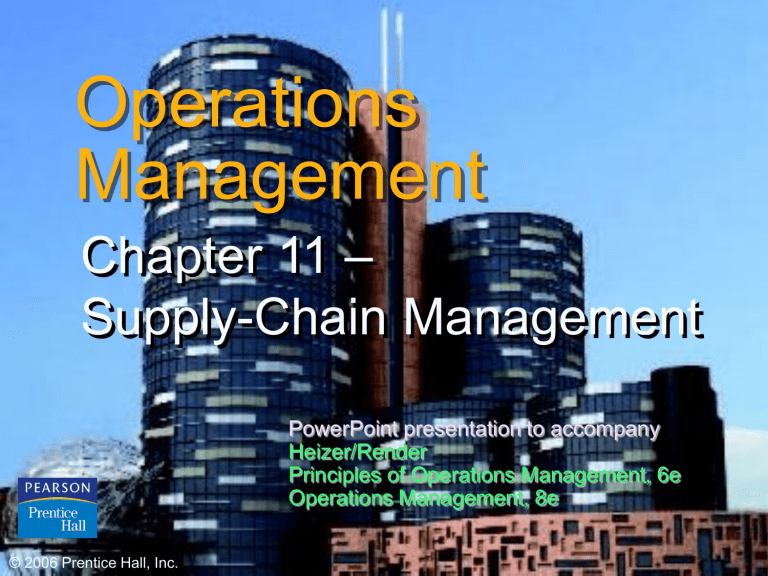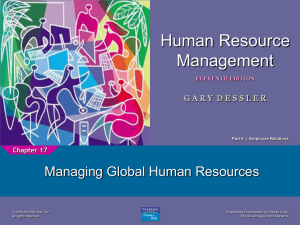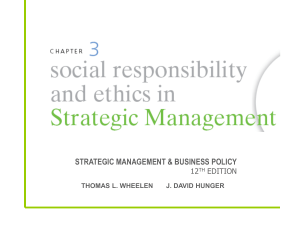
Operations Management Chapter 11 – Supply-Chain Management PowerPoint presentation to accompany Heizer/Render Principles of Operations Management, 6e Operations Management, 8e © 2006 Prentice Hall, Inc. Hall, Inc. © 2006 Prentice 11 – 1 The Strategic Importance of the Supply Chain Supply-chain management is the integration of the activities that procure materials and services, transform them into intermediate goods and the final product, and deliver them to customers Competition is no longer between companies; it is between supply chains © 2006 Prentice Hall, Inc. 11 – 2 SCM vs Traditional Purchasing • Traditional purchasing focuses on initial cost; SCM focuses on total cost of ownership • Traditional purchasing tries to negotiate the price that is best for the purchaser; SCM focuses on negotiating a price that is best for the entire supply chain. © 2006 Prentice Hall, Inc. 11 – 3 A Supply Chain Figure 11.1 © 2006 Prentice Hall, Inc. 11 – 4 Supply Chain Flows Material Flow Ultimate customer Initial supplier Information Flow There must be a good inter-organizational information provide the required information flow. © 2006 Prentice Hall, Inc. 11 – 5 Supply Chain Focus • Traditional purchasing focuses on the flow of goods and information from the immediate supplier and immediate customer; SCM focuses on the flow of goods and information from initial supplier to ultimate customer. © 2006 Prentice Hall, Inc. 11 – 6 Supply-Chain Economics Supply Chain Costs as a Percent of Sales Industry All industry Automobile Food Lumber Paper Petroleum Transportation % Purchased 52 67 60 61 55 79 62 Table 11.2 © 2006 Prentice Hall, Inc. 11 – 7 Supply-Chain Economics Dollars of additional sales needed to equal $1 saved through the supply chain Percent of Sales Spent in the Supply Chain Percent Net Profit of Firm 2 4 6 8 10 40% $3.23 $3.13 $3.03 $2.94 $2.86 50% $3.85 $3.70 $3.57 $3.45 $3.33 60% $4.76 $4.55 $4.35 $4.17 $4.00 70% $6.25 $5.88 $5.56 $5.26 $5.00 80% $9.09 $8.33 $7.69 $7.14 $6.67 90% $16.67 $14.29 $12.50 $11.11 $10.00 Table 11.3 © 2006 Prentice Hall, Inc. 11 – 8 Ethics in the Supply Chain Opportunities for unethical behavior are enormous and temptations are high Many companies have strict rules and codes of conduct that define acceptable behavior Institute for Supply Management (ISM) has developed a detailed set of principles and standards for ethical behavior © 2006 Prentice Hall, Inc. 11 – 9 Principles and Standards for Ethical Supply Management Conduct LOYALTY TO YOUR ORGANIZATION JUSTICE TO THOSE WITH WHOM YOU DEAL FAITH IN YOUR PROFESSION Table 11.5 © 2006 Prentice Hall, Inc. 11 – 10 Principles and Standards for Ethical Supply Management Conduct 1. Avoid the intent and appearance of unethical or compromising practice in relationships, actions, and communications 2. Demonstrate loyalty to the employer by diligently following the lawful instructions of the employer, using reasonable care and granted authority 3. Avoid any personal business or professional activity that would create a conflict between personal interests and the interests of the employer Table 11.5 © 2006 Prentice Hall, Inc. 11 – 11 Principles and Standards for Ethical Supply Management Conduct 4. Avoid soliciting or accepting money, loans, credits, or preferential discounts, and the acceptance of gifts, entertainment, favors, or services from present or potential suppliers that might influence, or appear to influence, supply management decisions 5. Handle confidential or proprietary information with due care and proper consideration of ethical and legal ramifications and government regulations 6. Promote positive supplier relationships through courtesy and impartiality 7. Avoid improper reciprocal agreements Table 11.5 © 2006 Prentice Hall, Inc. 11 – 12 Principles and Standards for Ethical Supply Management Conduct 8. Know and obey the letter and spirit of laws applicable to supply management 9. Encourage support for small, disadvantaged, and minority-owned businesses 10. Acquire and maintain professional competence 11. Conduct supply management activities in accordance with national and international laws, customs, and practices, your organization’s policies, and these ethical principles and standards of conduct 12. Enhance the stature of the supply management profession © 2006 Prentice Hall, Inc. Table 11.5 11 – 13 Managing the Supply Chain There are significant management issues in controlling a supply chain involving many independent organizations Mutual agreement on goals Trust Compatible organizational cultures © 2006 Prentice Hall, Inc. 11 – 14 Radio Frequency Tags © 2006 Prentice Hall, Inc. 11 – 15 Vendor Selection Vendor evaluation Critical decision Find potential vendors Determine the likelihood of them becoming good suppliers Vendor Development Training Engineering and production help Establish policies and procedures © 2006 Prentice Hall, Inc. 11 – 16 Vendor Selection Negotiations Cost-Based Price Model - supplier opens books to purchaser Market-Based Price Model - price based on published, auction, or indexed price Competitive Bidding - used for infrequent purchases but may make establishing long-term relationships difficult © 2006 Prentice Hall, Inc. 11 – 17 Vendor Evaluation Weights Scores (1-5) Weight x Score Engineering/research/innovation skills .20 5 1.0 Production process capability (flexibility/technical assistance) .15 4 .6 Distribution/delivery capability .05 4 .2 Quality systems and performance .10 2 .2 Facilities/location .05 2 .1 Financial and managerial strength (stability and cost structure) .15 4 .6 Information systems capability (ecommerce, Internet) .10 2 .2 Integrity (environmental compliance/ ethics) .20 5 1.0 Criteria Total © 2006 Prentice Hall, Inc. 1.00 3.9 11 – 18 Benchmarking SupplyChain Management Typical Firms Benchmark Firms 3.3% .8% 15 8 Time spent placing an order 42 minutes 15 minutes Percentage of late deliveries 33% 2% Percentage of rejected material 1.5% .0001% 400 4 Administrative costs as a percent of purchases Lead time (weeks) Number of shortages per year Table 11.6 © 2006 Prentice Hall, Inc. 11 – 19 Chapter 11 Quiz Record your answers to these questions on a Scantron 882 (the size we use for examinations). Bring this Scantron to Exam III and use it for the rest of the examination. The two questions on this quiz comprise the first two questions on Exam III. © 2006 Prentice Hall, Inc. 11 – 20 Chapter 11 Quiz 1. Supply chain management is concerned with a. The flow of goods and information from initial supplier to ultimate customer. b. The flow of goods and information from immediate supplier to immediate customer. c. Obtaining the absolute lowest priced materials from suppliers. d. Playing multiple suppliers against each other to obtain the lowest prices. e. Increasing the number of suppliers to obtain the lowest prices. © 2006 Prentice Hall, Inc. 11 – 21 Chapter 11 Quiz 2. A supplier invites you to attend a professional football game at his expense. You have no intention of letting this affect the amount of business you do with this supplier. According to the ISM Code of Ethics this might give the appearance of compromising practice and you should not accept the gift. a. True © 2006 Prentice Hall, Inc. b. False 11 – 22



